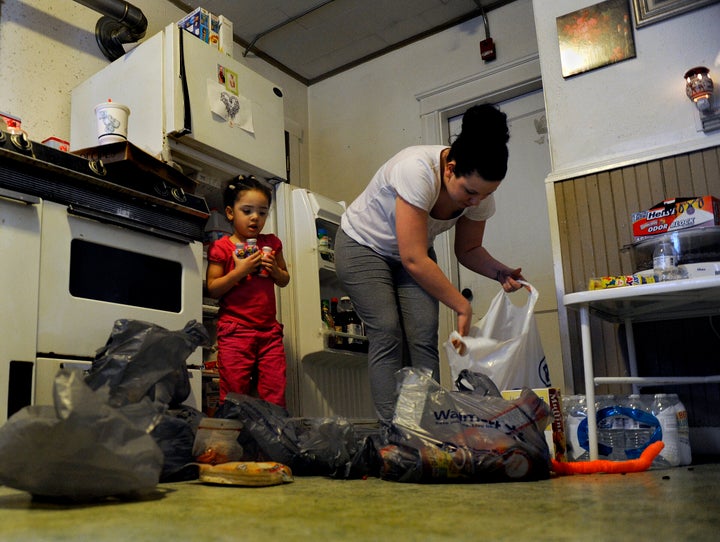The poorest American families are at danger of missing out on monthly checks under a new program from the Biden administration ― unless the government succeeds in finding a way to reach parents who are virtually anonymous to the IRS.
The Internal Revenue Service will start sending out checks of up to $300 per child every month to American families starting July 15 through 2021, it announced Monday. Families making $150,000 or less will receive the full benefit. Families making up to $400,000 will also receive some benefit.
President Joe Biden, Democratic lawmakers and administration officials have repeatedly said the policy will cut child poverty in the United States by half. But the government has to find a way to ensure aid gets to the very poor — something it has failed to do in the last year with similarly targeted financial relief.
Without a concerted effort from the government to reach out to these families, those that need help most could miss out.
“A lot of people don’t know that the credit is coming,” said Sergio Mata-Cisneros, a policy analyst with the Christian anti-hunger organization Bread for the World. “These are people who have a high rate of experiencing food insecurity and will benefit from the credit the most and it’s mostly also children of color so we are urging the administration to do outreach and work with community organizations in order to reach these people.”
The money that’s being distributed monthly is a boosted child tax credit. The American Rescue Plan, the nearly $2 trillion COVID-19 relief bill Biden signed in March, increased the child tax credits for middle- to low-income families from $2,000 to up to $3,600 and also instructed the IRS to pay the credit in advance, effectively creating a temporary child allowance through 2021. The law also got rid of the existing child tax credits’ income-based phase-in, basically opening up the benefit to families that have no income.
That means for this year, families should be receiving up to $300 per child every month from the IRS through December. The remaining benefit, which maxes out at $3,600 per child, will be given to parents with their 2021 tax return.
The problem: families in most dire need of financial aid aren’t in the IRS system. More than a third of children in poverty in the United States live in households that don’t file taxes, and more than half of those in what is considered deep poverty (50% below the poverty line) are in non-tax-filing households, according to the People’s Policy Project, a leftist think tank.
Democrats and administration officials are well aware of this issue.
“I think it’s important to remember setting this program up this fast is a huge undertaking especially given everything else IRS has been doing during the pandemic,” Nick Martin, a spokesperson for Rep. Suzan DelBene (D-Wash.), who has been leading the lobbying push in the House to make this expansion of the child tax credit permanent.
The solution so far has been a massive outreach operation.
“While most taxpayers will not be required to take any action to receive their payments, Treasury and the IRS will continue outreach efforts with partner organizations over the coming months to make more families aware of their eligibility,” the agency said in a statement Monday.
Congress approved three rounds of direct payments through the Coronavirus Aid, Relief, and Economic Security Act passed in March of 2020, and subsequent two COVID-19 relief bills, including the American Rescue Plan.
But an estimated 12 million working-age Americans missed out on the COVID relief direct payments because they didn’t file federal taxes, according to researchers with the Federal Reserve Bank of Minneapolis.
The IRS used data from the Social Security Administration, the Veterans Administration and Railroad Retirement Board to reach more nonfilers and set up an online tool for Americans who don’t file taxes to register for the payments. That only reached roughly 5.4 million Americans.

A Treasury Department official told HuffPost that the IRS will use all the data gathered last year through the CARES Act and the American Rescue Plan to expand the reach of the child tax credit program.
Outside groups were working to increase their outreach ahead of Monday’s Tax Day, and are now encouraging states to share data from antipoverty programs they administer, like Medicaid, SNAP or housing assistance. Many groups, as well as House Democratic leadership, has also been pushing the Biden administration to back a permanent expansion to the child text credit.
Mata-Cisneros said the administration has been open to a coordinated campaign with local organizations in order to increase awareness about the credit and get people signed into the online portal even if they don’t file taxes. Biden supported a four-year extension to the program in his recent American Families Plan proposal.
Democratic lawmakers too spent the last week hosting roundtable discussions with organizations to urge people to file federal taxes, even if they didn’t owe anything — a campaign they dubbed the “Child Tax Credit Week of Action.”
“It’s not a benefit if it isn’t used by those for whom it is intended to help,” House Speaker Nancy Pelosi said in a San Francisco panel on the issue on May 11.
Arthur Delaney contributed reporting.
